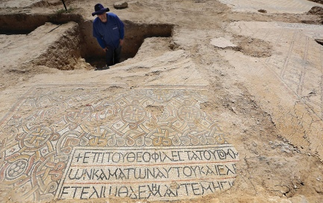Israel Hayom/Exclusive to JNS.org
A Byzantine monastery with an intricate mosaic floor has been discovered in the northern part of Israel’s Negev Desert. The site was unearthed during preservation work by the Israel Antiquities Authority (IAA) ahead of construction on a highway interchange.
Dr. Daniel Varga, the IAA archaeologist who directed the excavation, said that the monastery, located near the remains of the Byzantine-era town Horvat Hora, appeared “to be part of a series of monasteries [located] along a road that connected the Transjordan to the Beersheba valley.”
The structure, measuring 82 by 155 feet, is divided into halls built along an east-west axis, two of which stand out because of their spectacular mosaic floors. The prayer hall floor is adorned with a leaf-motif mosaic in strong shades of blue, red, yellow, and green. The floor of the dining hall features a colorful mosaic “carpet” decorated with images of plants, geometric designs, baskets, and a pair of birds.
The mosaic carpets bear four dedications in Greek that note the names of the heads of the monastery—Eliyahu, Nonus, Solomon, and Ilrion—as well as the dates on which the mosaics were completed in each of the rooms. These date the monastery to the second century C.E. One dedication also includes some Syriac words.
